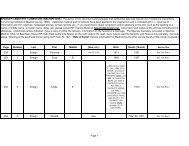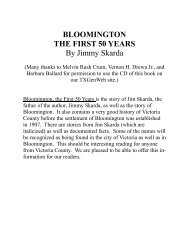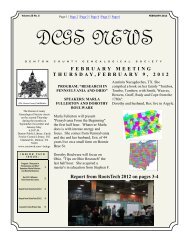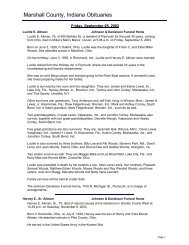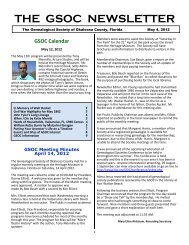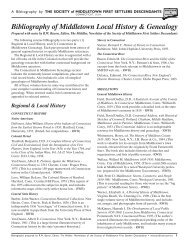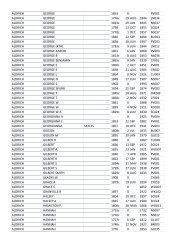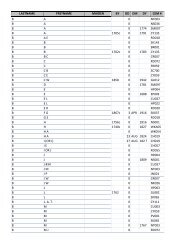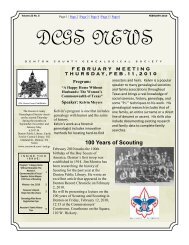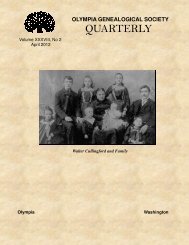Getting to the Roots of Your Family - RootsWeb - Ancestry.com
Getting to the Roots of Your Family - RootsWeb - Ancestry.com
Getting to the Roots of Your Family - RootsWeb - Ancestry.com
Create successful ePaper yourself
Turn your PDF publications into a flip-book with our unique Google optimized e-Paper software.
HANDWRITING<br />
Handwriting also varies somewhat from region <strong>to</strong> region and in each writer’s penmanship. It is <strong>of</strong>ten<br />
necessary <strong>to</strong> study many samples <strong>of</strong> <strong>the</strong> writer’s style <strong>to</strong> be able <strong>to</strong> determine a particularly difficult<br />
word or letter. Sample handwriting and printed Gothic scripts are available on various web sites. A<br />
three-part series on reading German handwritten records is available on www.familysearch.org on <strong>the</strong><br />
Wiki. Lesson One is at https://www.familysearch.org/learningcenter/lesson/reading-german-handwritten-records-lesson-1-kurrentletters/69.<br />
Ano<strong>the</strong>r good tu<strong>to</strong>rial is found at www.script.byu.edu.<br />
RESEARCH HELPS<br />
• A Gothic handwriting guide, genealogical word lists, a research outline, <strong>the</strong> Genealogical<br />
Handbook for German Research” and o<strong>the</strong>r helps can be found at www.familysearch.org by<br />
clicking on <strong>the</strong> word “guides”, “sorted by place”, and “G”, <strong>the</strong>n scrolling down <strong>to</strong> “Germany”.<br />
• A good web site for German genealogical reference material is www.genealogy.net/genealogy.<br />
This is a German web site with many sections available in both German and English. It contains<br />
many helpful links <strong>to</strong> o<strong>the</strong>r sites as well as reference material, such as gazetteers, listings <strong>of</strong><br />
<strong>to</strong>wn genealogies (Ortsfamilienbűcher), genealogical societies, emigration sources, and various<br />
word lists for occupations, illnesses, weights and measures, and calendars.<br />
• Foreign-language Web sites can be translated fairly well using http://translate.google.<strong>com</strong> .<br />
GENERAL INFORMATION<br />
Dates<br />
Dates may be abbreviated or written out in longhand. Prior <strong>to</strong> 1700 Roman numerals were <strong>of</strong>ten used<br />
<strong>to</strong> express <strong>the</strong> year. The months September through December may be written as “7bris, 8bris, 9bris,<br />
and Xbris or 10bris”. Feast days may be used <strong>to</strong> date events (i.e. “Thursday after <strong>the</strong> Sunday<br />
Misericordia”). Feat day calendars are available on <strong>the</strong> Internet. In many areas <strong>the</strong> French Republican<br />
Calendar was used from 1792 <strong>to</strong> 1804.<br />
Names<br />
The general rule is: “Spelling doesn’t count! Prior <strong>to</strong> 1900 names are spelled phonetically. Women’s<br />
surnames <strong>of</strong>ten include <strong>the</strong> female ending “in” <strong>to</strong> denote female gender. Both given names and<br />
surnames may be abbreviated. Alternate surnames may be indicated by words such as “vulgo” (known<br />
as), “oder” (or), and “genannt” (called).<br />
Abbreviations<br />
Recurring information, such as dates, places, titles, and occupations are <strong>of</strong>ten abbreviated. Symbols<br />
may denote <strong>the</strong> day <strong>of</strong> <strong>the</strong> week. Some <strong>com</strong>mon abbreviations are included in <strong>the</strong> word lists. Some<br />
knowledge <strong>of</strong> local and regional his<strong>to</strong>ry can help <strong>the</strong> reader decode unique abbreviations.<br />
RECORD TYPES<br />
Baptisms or christenings<br />
In <strong>the</strong> Roman Catholic Church, children were baptized as soon as possible after birth, <strong>of</strong>ten on <strong>the</strong><br />
same day. Lu<strong>the</strong>rans <strong>of</strong>ten waited from one <strong>to</strong> three days, and in <strong>the</strong> Reformed Church baptism may<br />
take place several weeks after birth. Anabaptist groups did not practice infant baptism and <strong>of</strong>ten kept<br />
no baptismal registers.



